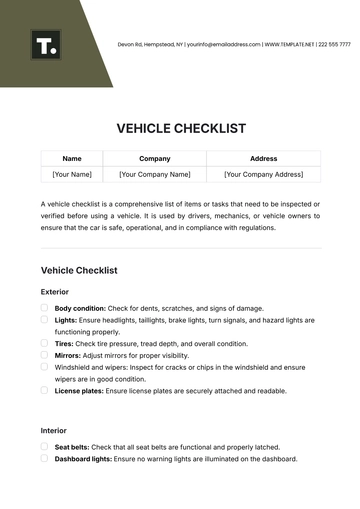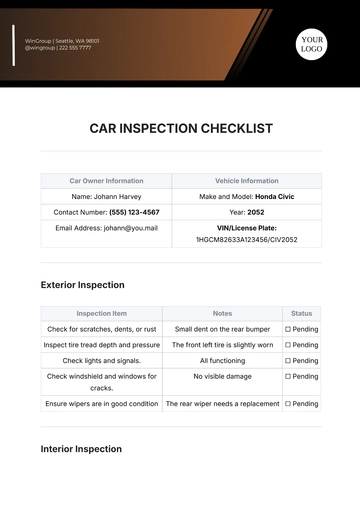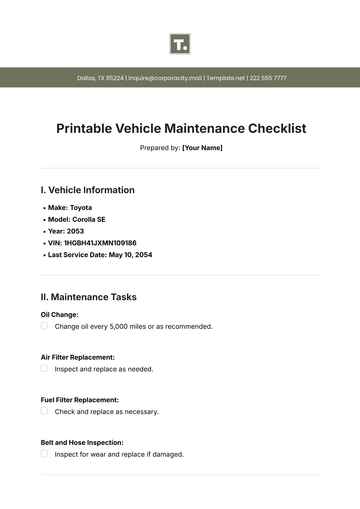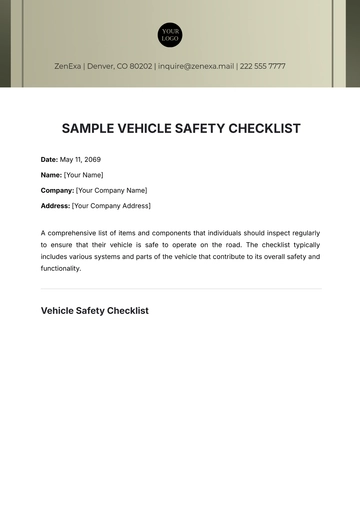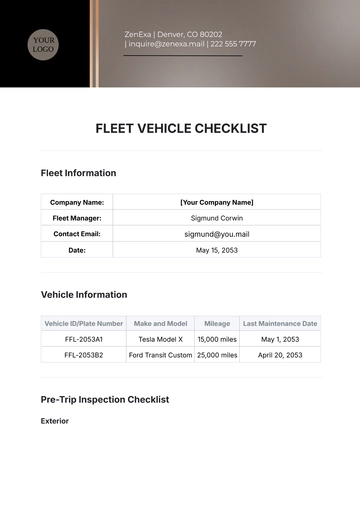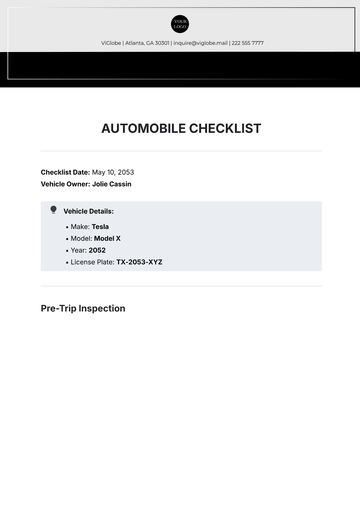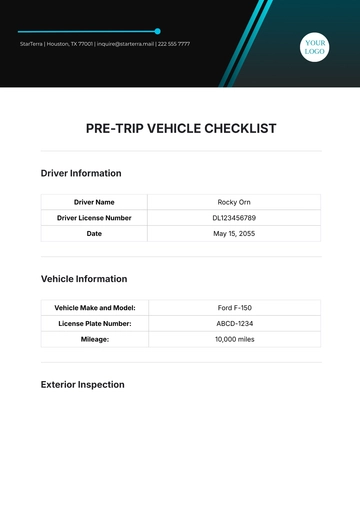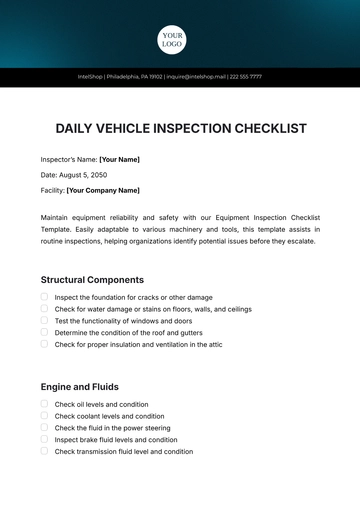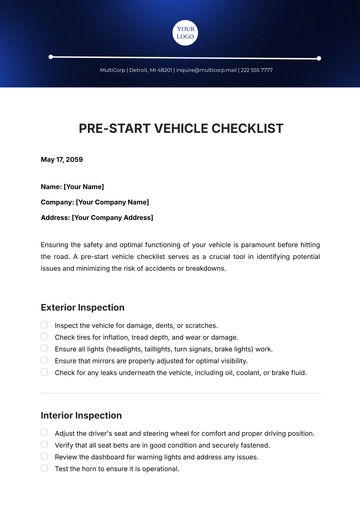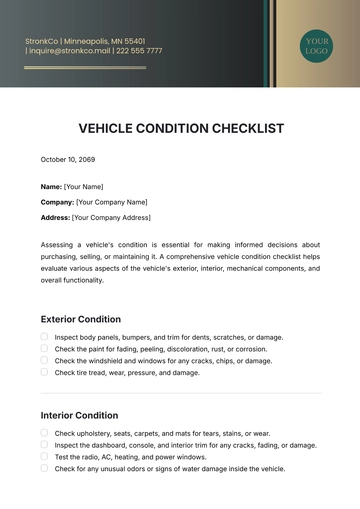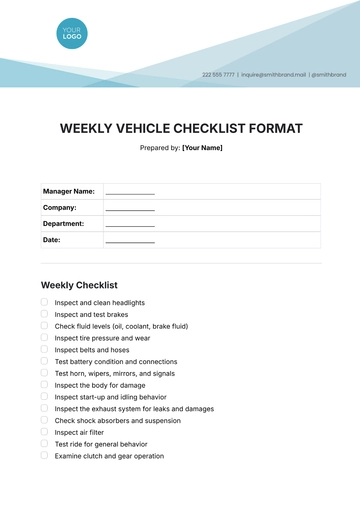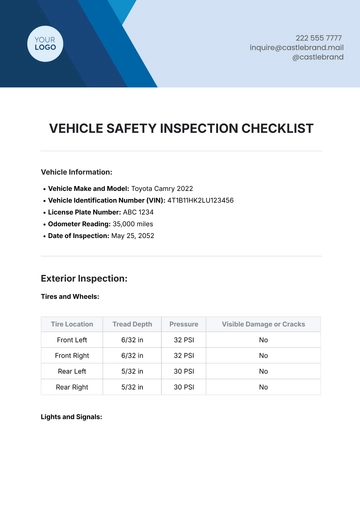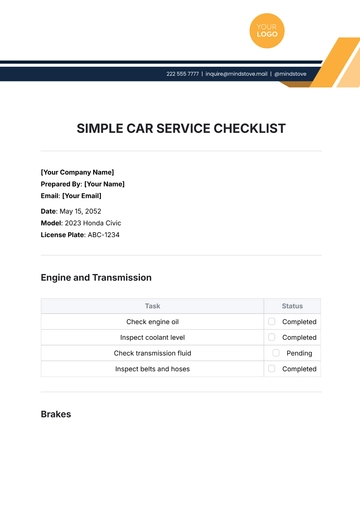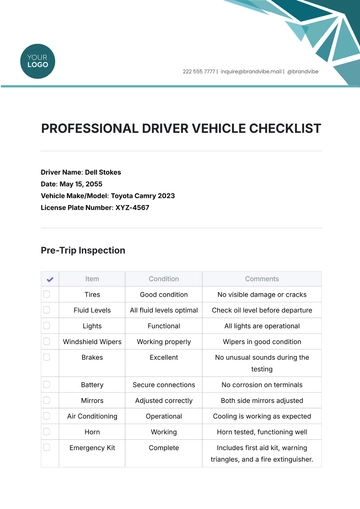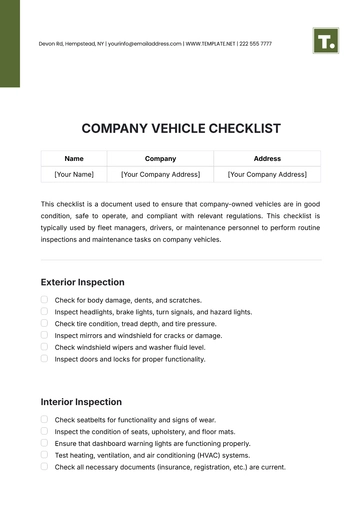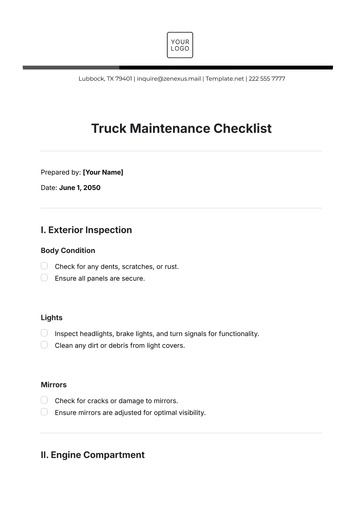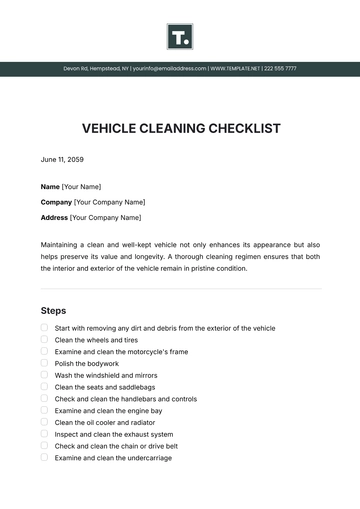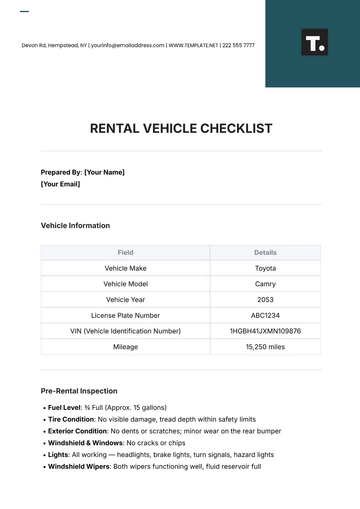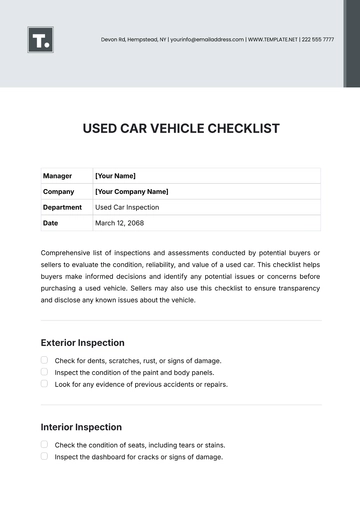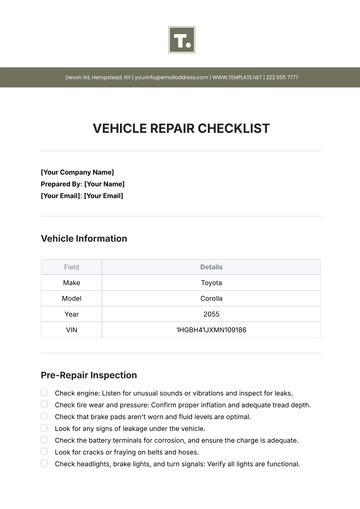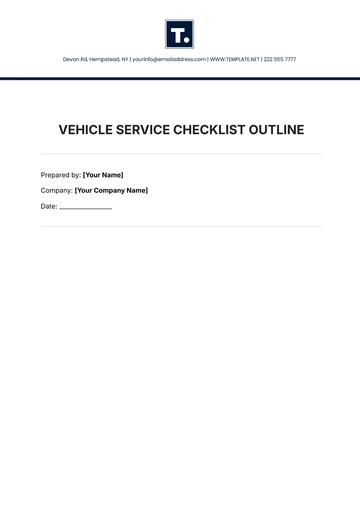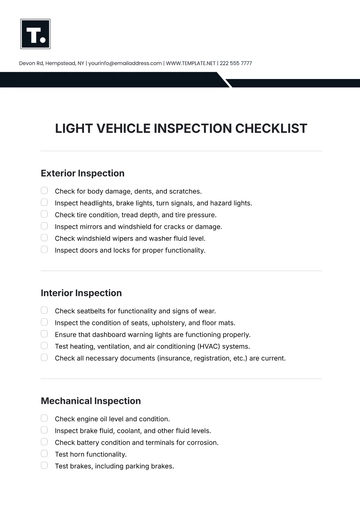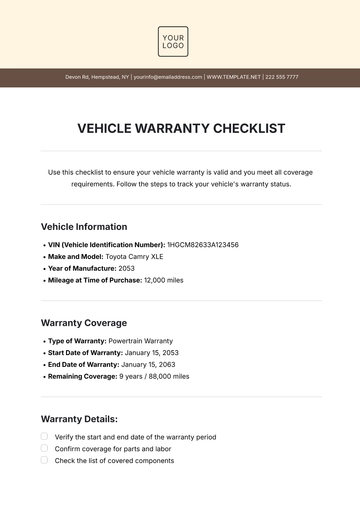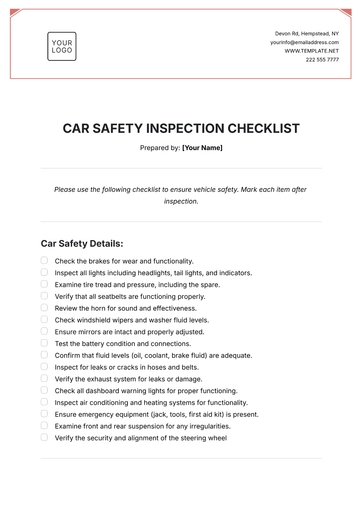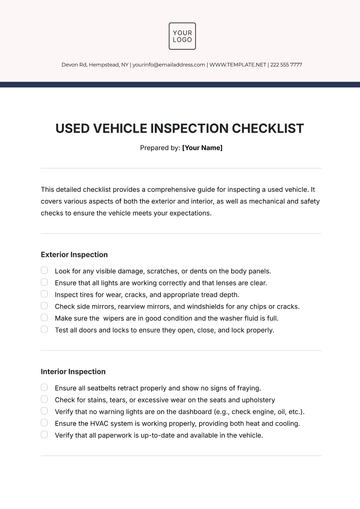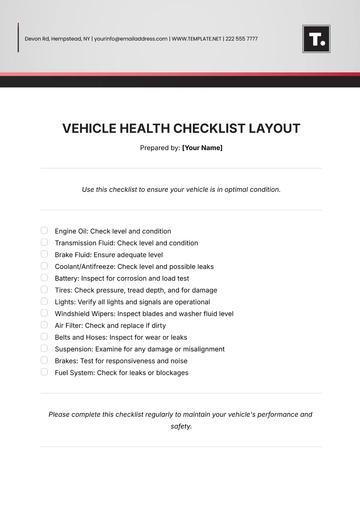Free Vehicle Compliance Checklist
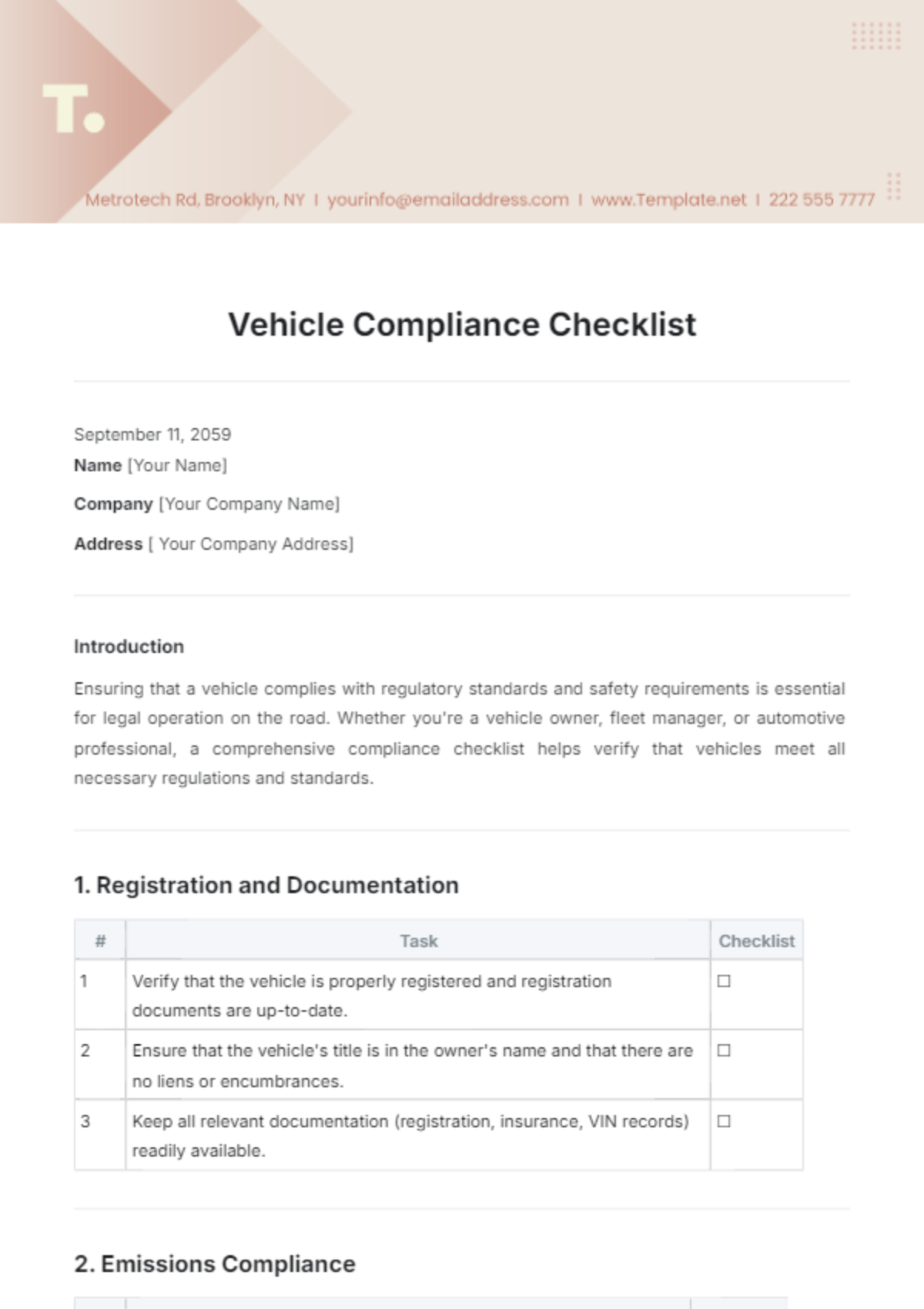
September 11, 2059
Name [Your Name]
Company [Your Company Name]
Address [ Your Company Address]
Introduction
Ensuring that a vehicle complies with regulatory standards and safety requirements is essential for legal operation on the road. Whether you're a vehicle owner, fleet manager, or automotive professional, a comprehensive compliance checklist helps verify that vehicles meet all necessary regulations and standards.
1. Registration and Documentation
# | Task | Checklist |
|---|---|---|
1 | Verify that the vehicle is properly registered and registration documents are up-to-date. | ☐ |
2 | Ensure that the vehicle's title is in the owner's name and that there are no liens or encumbrances. | ☐ |
3 | Keep all relevant documentation (registration, insurance, VIN records) readily available. | ☐ |
2. Emissions Compliance
# | Task | Checklist |
|---|---|---|
1 | Check for compliance with emissions standards and regulations in your jurisdiction. | ☐ |
2 | Ensure the vehicle has passed any required emissions tests. | ☐ |
3 | Verify the emissions control system is functioning properly. | ☐ |
4 | Keep records of emissions testing and compliance certificates. | ☐ |
3. Safety Equipment and Features
# | Task | Checklist |
|---|---|---|
1 | Verify that the vehicle is equipped with seat belts, airbags, and child restraint systems. | ☐ |
2 | Inspect safety equipment: headlights, taillights, turn signals, brake lights, and windshield wipers. | ☐ |
3 | Ensure safety equipment meets regulatory standards and is properly maintained. | ☐ |
4. Vehicle Inspections
# | Task | Checklist |
|---|---|---|
1 | Schedule regular vehicle inspections for safety and mechanical compliance. | ☐ |
2 | Conduct pre-trip inspections to identify any issues or concerns. | ☐ |
3 | Address safety or compliance issues promptly to maintain roadworthiness. | ☐ |
5. Compliance with Weight and Load Limits
# | Task | Checklist |
|---|---|---|
1 | Ensure compliance with weight and load limits set by regulatory authorities. | ☐ |
2 | Verify cargo is properly secured and distributed to prevent overloading. | ☐ |
3 | Adhere to axle weight limits and avoid exceeding maximum payload capacities. | ☐ |
6. Maintenance and Service Records
# | Task | Checklist |
|---|---|---|
1 | Maintain detailed records of vehicle maintenance and service history. | ☐ |
2 | Follow manufacturer recommendations for maintenance and service intervals. | ☐ |
3 | Keep records of repairs and modifications, noting any that affect compliance with standards. | ☐ |
- 100% Customizable, free editor
- Access 1 Million+ Templates, photo’s & graphics
- Download or share as a template
- Click and replace photos, graphics, text, backgrounds
- Resize, crop, AI write & more
- Access advanced editor
Ensure legal and safety standards with Template.net's Vehicle Compliance Checklist Template. This editable and customizable tool is essential for meeting regulatory requirements. Adapt it to any vehicle using our Ai Editor Tool, ensuring all inspections cover necessary compliance points. Perfect for commercial fleets or personal use, maintain peace of mind with up-to-date and thorough checks.
You may also like
- Cleaning Checklist
- Daily Checklist
- Travel Checklist
- Self Care Checklist
- Risk Assessment Checklist
- Onboarding Checklist
- Quality Checklist
- Compliance Checklist
- Audit Checklist
- Registry Checklist
- HR Checklist
- Restaurant Checklist
- Checklist Layout
- Creative Checklist
- Sales Checklist
- Construction Checklist
- Task Checklist
- Professional Checklist
- Hotel Checklist
- Employee Checklist
- Moving Checklist
- Marketing Checklist
- Accounting Checklist
- Camping Checklist
- Packing Checklist
- Real Estate Checklist
- Cleaning Checklist Service
- New Employee Checklist
- Food Checklist
- Home Inspection Checklist
- Advertising Checklist
- Event Checklist
- SEO Checklist
- Assessment Checklist
- Inspection Checklist
- Baby Registry Checklist
- Induction Checklist
- Employee Training Checklist
- Medical Checklist
- Safety Checklist
- Site Checklist
- Job Checklist
- Service Checklist
- Nanny Checklist
- Building Checklist
- Work Checklist
- Office Checklist
- Training Checklist
- Website Checklist
- IT and Software Checklist
- Performance Checklist
- Project Checklist
- Startup Checklist
- Education Checklist
- Home Checklist
- School Checklist
- Maintenance Checklist
- Planning Checklist
- Manager Checklist
- Wedding Checklist
- Vehicle Checklist
- Travel Agency Checklist
- Vehicle Inspection Checklist
- Interior Design Checklist
- Backpacking Checklist
- Business Checklist
- Legal Checklist
- Nursing Home Checklist
- Weekly Checklist
- Recruitment Checklist
- Salon Checklist
- Baby Checklist
- Equipment Checklist
- Trade Show Checklist
- Party Checklist
- Hospital Bag Checklist
- Evaluation Checklist
- Agency Checklist
- First Apartment Checklist
- Hiring Checklist
- Opening Checklist
- Small Business Checklist
- Rental Checklist
- College Dorm Checklist
- New Puppy Checklist
- University Checklist
- Building Maintenance Checklist
- Work From Home Checklist
- Student Checklist
- Application Checklist
